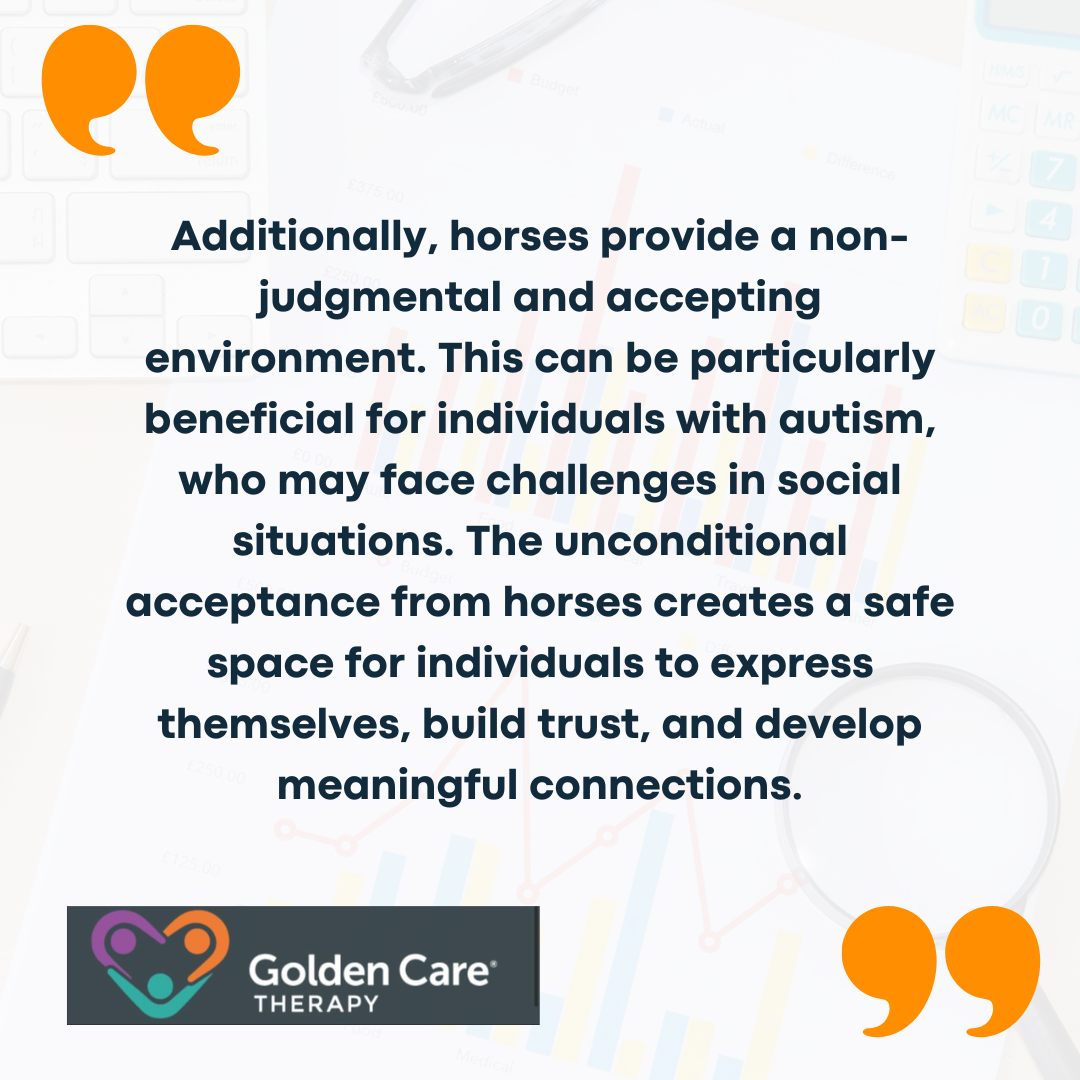Horse therapy, also known as equine-assisted therapy, has shown promising results in benefiting individuals with autism spectrum disorder (ASD).
Studies have indicated that horse therapy can lead to improvements in irritability and hyperactivity in individuals with autism. A notable study conducted by Robin Gabriels and her team in 2015 involved 127 participants with ASD.
The study found that children who participated in a 10-week horse therapy program exhibited reduced irritability and hyperactivity compared to children engaged in barn activities without interacting with horses. The positive effects were sustained even six months after therapy, with continued reductions in irritability.
Moreover, researchers at the University of Colorado Anschutz Medical Campus have observed significantly reduced irritability in autistic children through horse riding. This effect has been observed both in the short-term and long-term, indicating the potential long-lasting benefits of horse therapy for managing irritability in individuals with ASD.

Improvement in Communication Skills
Horse therapy has been found to have a positive impact on communication skills in individuals with autism. The interaction with horses provides opportunities for practicing and improving communication and language abilities.
Through horse therapy, individuals with autism can engage with supervisors, instructors, or therapists, which helps them develop social communication skills.
Interacting with horses requires individuals to give direct instructions, reinforcing verbal communication effectiveness. This experience fosters a sense of accomplishment and boosts self-confidence.
A study conducted by Robin Gabriels and her team found that children who participated in horse therapy demonstrated increased word fluency compared to children engaged in barn activities without interacting with horses. The positive effects on social communication and word fluency were sustained even after six months.

Sensory Benefits of Horse Therapy
Horse therapy has shown significant sensory benefits for individuals with autism. Children with autism often experience sensory processing issues, and horse riding can positively impact various sensory aspects, including visual, auditory, movement, and scent.
Engaging in horse-riding therapy exposes individuals with autism to a range of visual and auditory stimuli. The visual experience of being around horses, observing their movements, and interacting with them can enhance visual perception and tracking skills.
This can be particularly beneficial for individuals who struggle with visual focus and attention.
Besides, the auditory aspects of horse riding, such as the sound of hooves on the ground, the horse’s breathing, and the overall environment, provide opportunities for individuals with autism to develop auditory processing skills. The rhythmic sounds and patterns of horse movement can help in improving auditory discrimination and attention.

Emotional and Behavioral Improvements
Emotional and behavioral improvements are also often observed among autistic individuals undergoing horse therapy. Accordingly, it has been found to have a calming effect on individuals with autism by helping reduce hyperactivity and enhance focus.
Additionally, the rhythmic experiences provided during horse riding can be soothing and beneficial for emotional regulation. A follow-up study to that of Robin Gabriels’ involved 64 children who, after six months, found continued reductions in irritability and sustained improvements in social communication and word fluency in the riding group.
Horse riding can help children with autism control and calm hyperactivity, allowing them to focus on tasks more effectively.
Development of Communication Skills
Horse therapy also provides a unique and effective platform for individuals with autism to develop and enhance their communication skills. Through interactions with horses, individuals can practice verbal communication and experience a sense of accomplishment.
In horse therapy programs, individuals with autism can engage in verbal communication with horses. They can give direct instructions to the horse, such as commands for walking, stopping, or changing directions.
These interactions not only promote communication but also help individuals develop their language skills.
Horses are non-judgmental and provide a safe and supportive environment for individuals to practice their verbal communication. They offer immediate feedback to the individual’s verbal cues, reinforcing the importance of clear and effective communication.
This practice with horses can then translate to improved communication with others in different social situations.

Therapeutic Horsemanship Programs
Therapeutic Horsemanship programs play a significant role in helping individuals with autism develop essential life skills, gain independence, and foster new perspectives through interactions with horses.
These programs aim to empower individuals with autism to live life to the fullest, enhancing their overall well-being and quality of life.
One of the key objectives of Therapeutic Horsemanship programs is to teach individuals with autism valuable life skills that can contribute to their independence. Through working with horses, participants learn responsibility, patience, and empathy.
They acquire practical skills such as grooming, feeding, and caring for the horses, which can be transferred to other aspects of their daily lives.
Interacting with horses requires individuals to follow instructions, establish routines, and communicate effectively. These programs provide a structured environment where participants can practice and develop these skills, promoting self-confidence and a sense of achievement.
Gaining New Perspectives Through Horse Interaction
Horse interaction in Therapeutic Horsemanship programs offers a unique opportunity for individuals with autism to gain new perspectives. By observing and interacting with horses, individuals can learn to understand non-verbal cues, body language, and emotional responses. This helps them develop empathy and improve their ability to interpret social cues in their interactions with others.

Similar to having an autism service dog, the experience of working with horses can also foster a sense of accomplishment and pride. Anecdotal evidence from parents and teachers often highlights the surprise and joy of discovering hidden abilities and skills in individuals participating in Therapeutic Horsemanship programs. This recognition of their capabilities can boost self-esteem and motivate further personal growth.
Through Therapeutic Horsemanship programs, individuals with autism have the opportunity to develop life skills, gain independence, and broaden their perspectives. The positive outcomes that were observed in participants highlight the effectiveness of these programs in improving the overall well-being and quality of life for individuals with autism.
Research continues to shed light on the neurological basis of sensory issues in autism, offering hope for more targeted and effective therapies in the future. By recognizing and addressing sensory processing difficulties, we can improve the quality of life for individuals with autism and their families. If you’re seeking specialized ABA therapy in New Jersey, Indiana, Georgia, and New York, Golden Care offers comprehensive services tailored to meet the unique needs of each individual. Contact us to learn more or book a consultation today.
Sources:
https://www.autismspeaks.org/expert-opinion/equine-therapy-autism
https://autism.org/horse-therapy-autism
https://www.forcesequine.com/news/5-ways-horse-riding-can-benefit-children-with-autism
https://www.fei.org/stories/lifestyle/horse-human/horses-world-autism-month



